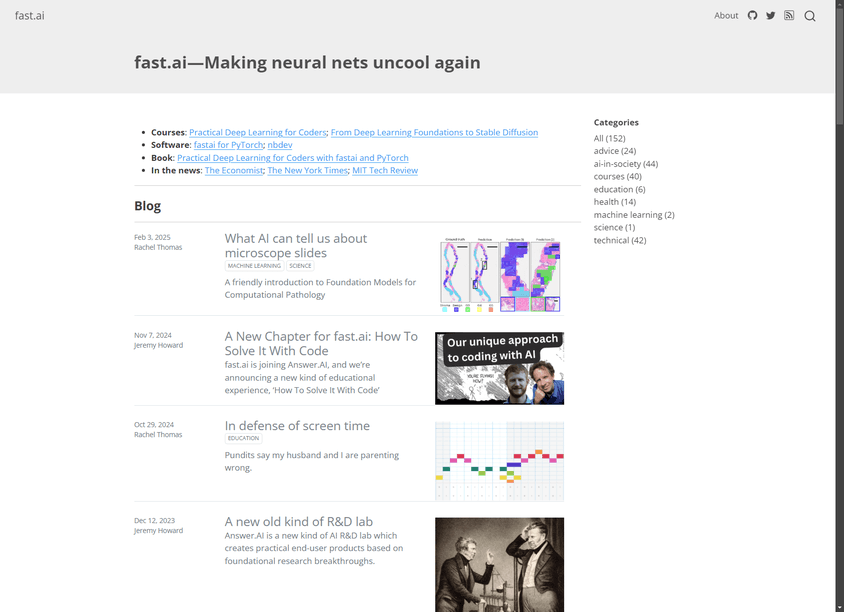What is Fast.ai
Discover Fast.ai's free courses and open-source library for practical deep learning implementation. Learn cutting-edge techniques through hands-on projects and community-driven education.

Overview of Fast.ai
- Deep Learning Framework: Fast AI is an open-source deep learning library built on PyTorch that provides layered APIs for both practitioners seeking state-of-the-art results and researchers requiring customizable components.
- Educational Ecosystem: Developed alongside practical courses by Jeremy Howard and Rachel Thomas, Fast AI emphasizes accessibility through its 'top-down' teaching approach paired with production-ready code implementations.
- Domain-Specific Optimization: Offers specialized toolkits for vision, text processing, tabular data analysis, and collaborative filtering with integrated best practices from recent research papers.
Use Cases for Fast.ai
- Medical Imaging Analysis: Researchers leverage Fast AI's GPU-optimized vision modules with DICOM support for rapid prototyping of diagnostic models using limited datasets.
- Transfer Learning Deployment: Computer vision teams achieve production-grade image classification models in under five code lines using pretrained architectures like ResNet variants.
- NLP Pipeline Development: Natural language processing engineers utilize ULMFiT-inspired workflows from Fast AI's text module for domain-specific language model fine-tuning.
- Recommendation Systems: E-commerce platforms implement collaborative filtering APIs to build personalized product suggestion engines with implicit feedback handling.
Key Features of Fast.ai
- Intelligent Defaults System: Automatically selects optimal loss functions, validation strategies, and transfer learning parameters based on data characteristics through unified classes like Learner and DataLoaders.
- Modular Architecture: Combines PyTorch flexibility with high-level abstractions through decoupled components including XResNet blocks, merge layers for custom connections, and GPU-optimized vision operations.
- Advanced Training Utilities: Implements progressive resizing for accelerated image processing, discriminative learning rates for fine-tuning efficiency, and novel callback systems enabling mid-training parameter adjustments.
Final Recommendation for Fast.ai
- Ideal for Applied ML Teams: Combines rapid prototyping capabilities with research-grade customization options suitable for startups to enterprise deployments.
- Recommended for Educational Programs: Integrated course materials paired with battle-tested code patterns make it exceptional for teaching practical deep learning concepts.
- Essential for PyTorch Practitioners: Serves as complementary toolkit enhancing native PyTorch workflows through optimized training loops and architectural best practices.
Frequently Asked Questions about Fast.ai
What is Fast.ai?▾
Fast.ai is an open, practical deep learning initiative that provides free courses, an open-source library, and community resources to help people learn and apply machine learning quickly and effectively.
Are Fast.ai courses and libraries free to use?▾
Yes — the educational materials and the library are available at no charge; the codebase is open source, though you should consult the project site or repository for exact licensing and usage terms.
What prerequisites do I need to start with Fast.ai courses?▾
You should be comfortable with basic Python and have some familiarity with programming and high-level math concepts; many courses are designed to be practical and beginner-friendly, with resources to help you catch up as you go.
How does the Fast.ai library relate to PyTorch?▾
The Fast.ai library is built on top of PyTorch and provides higher-level, opinionated APIs and utilities to accelerate model development, training, and experimentation.
How do I install the Fast.ai library?▾
Installation is typically done via standard Python package managers (pip or conda) and requires a compatible PyTorch installation; follow the official installation guide on the project website or repository for platform-specific instructions.
Can I use Fast.ai models in production or for commercial projects?▾
In general, models and code from open-source Fast.ai projects can be adapted for production and commercial use, but you should review the repository license and follow standard testing, validation, and deployment best practices before productionizing.
What hardware do I need to run Fast.ai projects?▾
A GPU is recommended for training modern deep learning models to get reasonable training times, though many tutorials and smaller experiments can run on CPU or cloud GPU instances for learning purposes.
What is the format of Fast.ai courses and learning materials?▾
Courses combine lecture videos, hands-on Jupyter/Colab notebooks, practical assignments, and readings, emphasizing code-first, project-based learning to help you build real models quickly.
Where can I get help if I run into problems?▾
You can seek help via the Fast.ai community forum, the project's GitHub issues, and the official documentation; community members and contributors frequently assist with setup and troubleshooting.
How can I contribute to Fast.ai?▾
You can contribute by reporting issues, submitting pull requests to the codebase or documentation, creating tutorials, or helping on the community forum; check the project's contribution guidelines for details on the preferred workflow.
User Reviews and Comments about Fast.ai
Loading comments…



